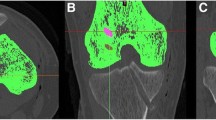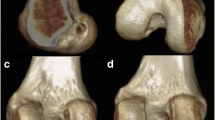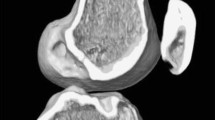Abstract
Purpose
The quadrant method was described by Bernard et al. and it has been widely used for postoperative evaluation of anterior cruciate ligament (ACL) reconstruction. The purpose of this research is to further develop the quadrant method measuring four points, which we named four-point quadrant method, and to compare with the quadrant method.
Methods
Three-dimensional computed tomography (3D-CT) analyses were performed in 25 patients who underwent double-bundle ACL reconstruction using the outside-in technique. The four points in this study’s quadrant method were defined as point1—highest, point2—deepest, point3—lowest, and point4—shallowest, in femoral tunnel position. Value of depth and height in each point was measured. Antero-medial (AM) tunnel is (depth1, height2) and postero-lateral (PL) tunnel is (depth3, height4) in this four-point quadrant method. The 3D-CT images were evaluated independently by 2 orthopaedic surgeons. A second measurement was performed by both observers after a 4-week interval. Intra- and inter-observer reliability was calculated by means of intra-class correlation coefficient (ICC). Also, the accuracy of the method was evaluated against the quadrant method.
Results
Intra-observer reliability was almost perfect for both AM and PL tunnel (ICC > 0.81). Inter-observer reliability of AM tunnel was substantial (ICC > 0.61) and that of PL tunnel was almost perfect (ICC > 0.81). The AM tunnel position was 0.13% deep, 0.58% high and PL tunnel position was 0.01% shallow, 0.13% low compared to quadrant method.
Conclusions
The four-point quadrant method was found to have high intra- and inter-observer reliability and accuracy. This method can evaluate the tunnel position regardless of the shape and morphology of the bone tunnel aperture for use of comparison and can provide measurement that can be compared with various reconstruction methods. The four-point quadrant method of this study is considered to have clinical relevance in that it is a detailed and accurate tool for evaluating femoral tunnel position after ACL reconstruction.
Level of Evidence
Case series, Level IV.


Similar content being viewed by others
References
Ajuied A, Wong F, Smith C, Norris M, Earnshaw P, Back D, Davies A (2014) Anterior cruciate ligament injury and radiologic progression of knee osteoarthritis: a systematic review and meta-analysis. Am J Sports Med 42(9):2242–2252
Bernard M, Hertel P, Hornung H, Cierpinski T (1997) Femoral insertion of the ACL. Radiographic quadrant method. Am J Knee Surg 10:14–22
Colombet P, Robinson J, Christel P, Franceschi JP, Djian P, Bellier G, Sbihi A (2006) Morphology of anterior cruciate ligament attachments for anatomic reconstruction: a cadaveric dissection and radiographic study. Arthroscopy 22(9):984–992
Dugas JR, Pace JL, Bolt B, Wear SA, Beason DP, Cain EL Jr (2014) Evaluation and comparison of femoral tunnel placement during anterior cruciate ligament reconstruction using 3-dimensional computed tomography: effect of notchplasty on transtibial and medial portal drilling. Orthop J Sports Med. https://doi.org/10.1177/2325967114525572
Forsythe B, Kopf S, Wong AK, Martins CA, Anderst W, Tashman S, Fu FH (2010) The location of femoral and tibial tunnels in anatomic double-bundle anterior cruciate ligament reconstruction analyzed by three-dimensional computed tomography models. J Bone Jt Surg Am 92(6):1418–1426
Giron F, Cuomo P, Aglietti P, Bull AM, Amis AA (2006) Femoral attachment of the anterior cruciate ligament. Knee Surg Sports Traumatol Arthrosc 14(3):250–256
Hoser C, Tecklenburg K, Kuenzel KH, Fink C (2005) Postoperative evaluation of femoral tunnel position in ACL reconstruction: plain radiography versus computed tomography. Knee Surg Sports Traumatol Arthrosc 13(4):256–262
Iriuchishima T, Ingham SJ, Tajima G, Horaguchi T, Saito A, Tokuhashi Y, Van Houten AH, Aerts MM, Fu FH (2010) Evaluation of the tunnel placement in the anatomical double-bundle ACL reconstruction: a cadaver study. Knee Surg Sports Traumatol Arthrosc 18(9):1226–1231
Iriuchishima T, Ryu K, Aizawa S, Fu FH (2016) Blumensaat’s line is not always straight: morphological variations of the lateral wall of the femoral intercondylar notch. Knee Surg Sports Traumatol Arthrosc 24(9):2752–2757
Kamath GV, Redfern JC, Greis PE, Burks RT (2011) Revision anterior cruciate ligament reconstruction. Am J Sports Med 39(1):199–217
Kim DH, Lim WB, Cho SW, Lim CW, Jo S (2016) Reliability of 3-dimensional computed tomography for application of the Bernard quadrant method in femoral tunnel position evaluation after anatomic anterior cruciate ligament reconstruction. Arthroscopy 32(8):1660–1666
Kopf S, Forsythe B, Wong AK, Tashman S, Anderst W, Irrgang JJ, Fu FH (2010) Nonanatomic tunnel position in traditional transtibial single-bundle anterior cruciate ligament reconstruction evaluated by three-dimensional computed tomography. J Bone Jt Surg Am 92(6):1427–1431
Landis JR, Koch GG (1977) The measurement of observer agreement for categorical data. Biometrics 33(1):159–174
Lee JK, Lee S, Seong SC, Lee MC (2015) Anatomy of the anterior cruciate ligament insertion sites: comparison of plain radiography and three-dimensional computed tomographic imaging to anatomic dissection. Knee Surg Sports Traumatol Arthrosc 23(8):2297–2305
Lertwanich P, Martins CA, Asai S, Ingham SJ, Smolinski P, Fu FH (2011) Anterior cruciate ligament tunnel position measurement reliability on 3-dimensional reconstructed computed tomography. Arthroscopy 27(3):391–398
Lorenz S, Elser F, Mitterer M, Obst T, Imhoff AB (2009) Radiologic evaluation of the insertion sites of the 2 functional bundles of the anterior cruciate ligament using 3-dimensional computed tomography. Am J Sports Med 37(12):2368–2376
Matassi F, Sirleo L, Carulli C, Innocenti M (2015) Anatomical anterior cruciate ligament reconstruction: transtibial versus outside–in technique. Joints 3(1):6–14
Miller CD, Gerdeman AC, Hart JM, Bennett CG, Golish SR, Gaskin C, Miller MD (2011) A comparison of 2 drilling techniques on the femoral tunnel for anterior cruciate ligament reconstruction. Arthroscopy 27(3):372–379
Muneta T, Yamamoto H, Sakai H, Ishibashi T, Furuya K (1993) Relationship between changes in length and force in in vitro reconstructed anterior cruciate ligament. Am J Sports Med 21(2):299–304
Murawski CD, Wolf MR, Araki D, Muller B, Tashman S, Fu FH (2013) Anatomic anterior cruciate ligament reconstruction: current concepts and future perspective. Cartilage 4(3):27S-37S
Musahl V, Plakseychuk A, VanScyoc A, Sasaki T, Debski RE, McMahon PJ, Fu FH (2005) Varying femoral tunnels between the anatomical footprint and isometric positions: effect on kinematics of the anterior cruciate ligament-reconstructed knee. Am J Sports Med 33(5):712–718
Park JS, Park JH, Wang JH, Oh CH, Hwang MH, Lee SH, Kim JG (2015) Comparison of femoral tunnel geometry, using in vivo 3-dimensionalcomputed tomography, during transportal and outside-in single-bundle anterior cruciate ligament reconstruction techniques. Arthroscopy 31(1):83–91
Pietrini SD, Ziegler CG, Anderson CJ, Wijdicks CA, Westerhaus BD, Johansen S, Engebretsen L, LaPrade RF (2011) Radiographic landmarks for tunnel positioning in double-bundle ACL reconstructions. Knee Surg Sports Traumatol Arthrosc 19(5):792–800
Shino K, Nakata K, Nakamura N, Toritsuka Y, Horibe S, Nakagawa S, Suzuki T (2008) Rectangular tunnel double-bundle anterior cruciate ligament reconstruction with bone–patellar tendon–bone graft to mimic natural fiber arrangement. Arthroscopy 24(10):1178–1183
Sim JA, Kim JM, Lee S, Bae JY, Seon JK (2017) Comparison of tunnel variability between trans‑portal and outside‑in techniques in ACL reconstruction. Knee Surg Sports Traumatol Arthrosc 25(4):1227–1233
Takeda Y, Iwame T, Takasago T, Kondo K, Goto T, Fujii K, Naruse A (2013) Comparison of tunnel orientation between transtibial and anteromedial portal techniques for anatomic double-bundle anterior cruciate ligament reconstruction using 3-dimensional computed tomography. Arthroscopy 29(2):195–204
Tashiro Y, Okazaki K, Uemura M, Toyoda K, Osaki K, Matsubara H, Hashizume M, Iwamoto Y (2014) Comparison of transtibial and transportal techniques in drilling femoral tunnels during anterior cruciate ligament reconstruction using 3D-CAD models. Open Access J Sports Med 5:65–72
Tsukada H, Ishibashi Y, Tsuda E, Fukuda A, Toh S (2008) Anatomical analysis of the anterior cruciate ligament femoral and tibial footprints. J Orthop Sci 13(2):122–129
Van Eck CF, Lesniak BP, Schreiber VM, Fu FH (2010) Anatomic single- and double-bundle anterior cruciate ligament reconstruction flowchart. Arthroscopy 26(2):258–268
Yamamoto Y, Hsu WH, Woo SL, Van Scyoc AH, Takakura Y, Debski RE (2004) Knee stability and graft function after anterior cruciate ligament reconstruction: a comparison of a lateral and an anatomical femoral tunnel placement. Am J Sports Med 32(8):1825–1832
Zantop T, Diermann N, Schumacher T, Schanz S, Fu FH, Petersen W (2008) Anatomical and nonanatomical double-bundle anterior cruciate ligament reconstruction: importance of femoral tunnel location on knee kinematics. Am J Sports Med 36(4):678–685
Zantop T, Petersen W, Sekiya JK, Muhsal V, Fu FH (2006) Anterior cruciate ligament anatomy and function relating to anatomical reconstruction. Knee Surg Sports Traumatol Arthrosc 14(10):982–992
Zantop T, Wellmann M, Fu FH, Petersen W (2008) Tunnel positioning of anteromedial and posterolateral bundles in anatomic anterior cruciate ligament reconstruction: anatomic and radiographic findings. Am J Sports Med 36(1):65–72
Zavras TD, Race A, Amis AA (2005) The effect of femoral attachment location on anterior cruciate ligament reconstruction: graft tension patterns and restoration of normal anterior–posterior laxity patterns. Knee Surg Sports Traumatol Arthrosc 13(2):92–100
Author information
Authors and Affiliations
Corresponding author
Ethics declarations
Conflict of interest
The authors declare that they have no conflict of interest.
Funding
The authors received no financial support for the research, authorship, and publication of this article.
Ethical approval
The study was approved by the Ethics Committee of Toho University Ohashi Medical Center (No. H16110).
Informed consent
Patient were informed, and they consented to conduct the study.
Rights and permissions
About this article
Cite this article
Mochizuki, Y., Kaneko, T., Kawahara, K. et al. The quadrant method measuring four points is as a reliable and accurate as the quadrant method in the evaluation after anatomical double-bundle ACL reconstruction. Knee Surg Sports Traumatol Arthrosc 26, 2389–2394 (2018). https://doi.org/10.1007/s00167-017-4797-y
Received:
Accepted:
Published:
Issue Date:
DOI: https://doi.org/10.1007/s00167-017-4797-y




